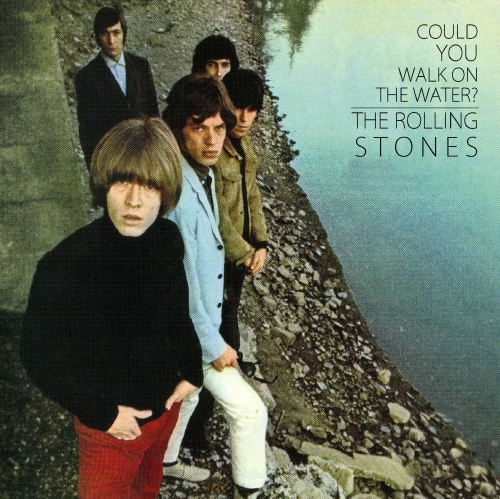

The Rolling Stones - Could YOU Walk On The Water? (rejected 1966 album)
This compilation is what is supposed to have been the first version of Aftermath.
By the end of 1965 the Stones had recorded a set of brand new songs and wanted them to be released under the title of "Could You Walk On The Water". However Decca refused to release the album because of its title. After some conflict and negociations it was agreed that the new album would be titled "Aftermath". However the band had recorded new songs in March 1966, and the original track list was changed to what became the regular track list of Aftermath.
The original tracklist was supposed to go like this :
Side One
19th Nervous Breakdown
Sad Day
Take It Or Leave It
Think
Mother's Little Helper
15:40min
Side Two
Goin' Home (short version)
Sittin' On A Fence
Don't You Follow Me (Doncha Bother original title)
Ride On, Baby
Looking Tired
14min
Full length : 29:36min
All tracks in stereo. (Except for Sad Day which seems to be an "enhanced" mono version)
All these tracks but one (Looking Tired) were recorded from December 3rd to December 8th at RCA Studios, Hollywood, USA.
"Looking Tired" was recorded on September 6th at RCA Studios and is an outtake from "Out Of Our Heads" sessions.
Jack Nitzche played piano on "Sad Day". Brian Jones played harpsichord on "Take It Or Leave It", "Sittin' On A Fence", and "Ride On Baby". Ian Stewart played piano on "Looking Tired".
------------------------------------------------
Informations taken from "It's Only Rock 'n' Roll - The Ultimate Guide to The Rolling Stones".
Tracks 3-9 from ABKCO 2002 remasters releases (Aftermath and Flowers albums)
Track 1 from "Hot Rocks 1964-1971" ("Stereo Audiophile" Bootleg)
Track 2 & 10 from "Could You Walk On Water" (Sister Morphine)
"Goin' Home" was edited to fit the original 3 minutes length.
------------------------------------------------
------------------------------------------------
Read more on Could You Walk On The Water :
(Article by Michael Lynch - 2006)
(...)
by late 1965, the Stones they were a-changin.' Early original compositions such as 1964's "Tell Me" were likeable rudimentary efforts, which eventually gave way to clever impressive rockers like "Satisfaction" and "The Last Time," but other products of the pens of Mick and Keith revealed the blossoming of true songwriting talent, such as the admonishing "Play With Fire," the sympathetic "Blue Turns To Gray," and melodic "The Singer Not The Song." (...)
So it was that in early December 1965, the five Stones, having reached the end of yet another American tour, entered RCA Studios in Hollywood, California (which for a year had been their favorite taping terrace) to record a new album. But from the get-go, the band knew this would be unlike their previous albums.
(...)
albums such as 'Out Of Our Heads' and 'Rolling Stones Now' were mixed bags of selections stemming from various spots in time: tracks from 1963 fell in (or didn't) with recordings from late 1965. But this new collection, as planned, would instead be culled strictly from material borne of this particular batch of sessions.
Additionally, as noted earlier, while most of their previous recordings were done in between tours, enforcing time limits on their productivity, this time The Stones, having just finished a tour could work at a more relaxed pace without having to rush to another town. The more leisurely circumstances allowed them some time to experiment, try and reject various ideas, and ensure the best performances possible. It would be the first time The Stones could, to quote Keith Richards, "treat every cut as if it were the single."
Also, since The Stones' songs were getting more melodic and introspective, and because Brian Jones had taken interest in various other instruments than his guitar and harmonica, the band was open to expanding their sound and going beyond their tried and true guitars, bass, drums lineup to underscore the messages of their new crop of songs and color them up. (...)
And... most notably... the new confidence in and prolificacy of Mick and Keith's songwriting resulted in the decision to, for the first time, record an album consisting entirely of original songs.
From a technical angle, another first resulted: It would be The Stones' first album in true stereo.
(...)
But back to December 1965: as expected, the sessions proved successful, and in just a matter of days, before flying back to their home country, they had put down an album's worth of material.
Side One: "19th Nervous Breakdown," "Sad Day," "Take It Or Leave It," "Think," "Mother's Little Helper."
Side Two: "Goin' Home," "Sitting On A Fence," "Doncha Bother Me," "Ride On Baby," and "Looking Tired."
Upon return to England, The Stones submitted the lineup and artwork to Decca, their UK record company, informing them also of their decided title: 'Could YOU Walk On Water,' and so ended 1965 for The Stones.
Unfortunately, Decca knew five musicians who most certainly could *not* walk on water, and let them know this by rejecting the album title. The Stones stood their ground and waited Decca out, hoping the label would give in, but when a few months into 1966 Decca still hadn't budged, The Stones conceded to changing the title. Changes didn't end there, however. By the time The Stones surrendered to Decca, they had since returned to RCA in Hollywood for another highly productive week of sessions, and wished to include some of these newer recordings on the forthcoming album, now to be called 'Aftermath.'
Full version available here : http://www.uppers.org/showArticle.asp?article=755